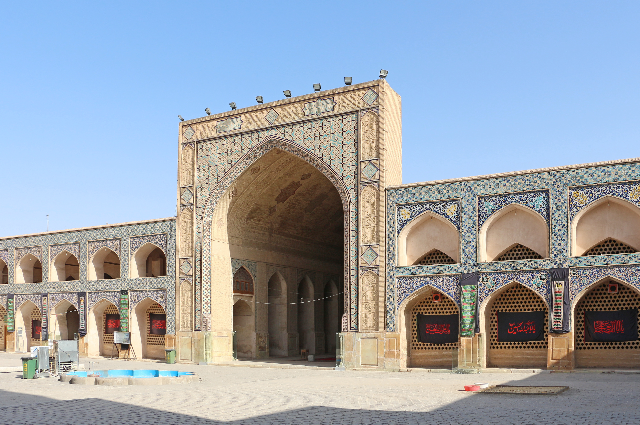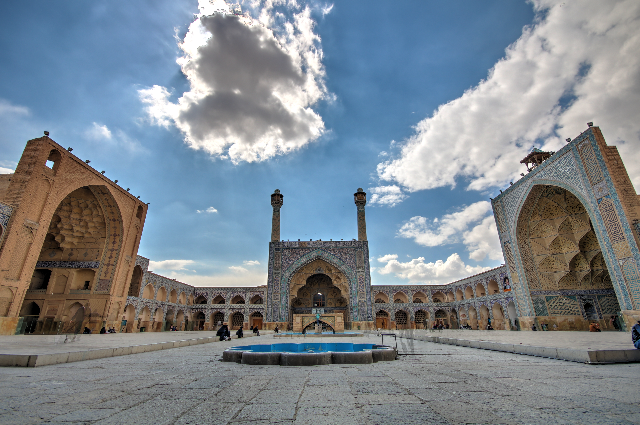
Source: Bernard Gagnon/wikimedia
In a world where people relate Islam to terrorism and words like islamophobia trending, we must understand what is the true essence of this ethical and moralistic religion. It is often believed that the beauty of a dynasty and belief can be well understood by its art such as its architecture, paintings, sculptures, etc. So to understand the true beauty of Islam and the message it wanted to give to the world let's travel through various monuments and places and understand Islamic Architecture. Islamic architecture depicts both secular and religious styles from the early history of Islam to the present day. One thing common in all of its monuments is the true ideals of Islam being exhibited and all of them portraying its religious ideals. Islamic architecture can be found in all Muslim majority countries and all of those countries which were once ruled by Muslim Rulers. The amount of detailing, encryptions embodied, jewels and their unique design elements including minarets, muqarnas, domes, and multifold arches make them special and unique. All the monuments are so well designed and give a sense of solidarity and inner peace as if every monument is a mosque or a religious place which connects you to god. To understand the spirit of Islam and its architecture better let us find ourselves lost in some mesmerizing and inspiring monuments.
The Alhambra
The first place is The Alhambra, both a palace and a fortress is located in Granada, Andalusia in Spain first built in 899 AD. The place was built by Muhammad I Ibn al-Ahmar, the first Nasrid emir. Alhambra’s eye catchy and prominent architecture is comprised of frescoes, stunning columns and arches, and deeply jeweled walls that admirably tell the story of a turbulent era in Iberian history. Every year thousands and lakhs of tourists visit this place to admire this Moorish paradise. While you are admiring its beauty you will hear tons of mysteries and stories that this palace imbibes. The palace’s original residents were Muslim emir. After the decline of Nasrid dynasty, it was abandoned and then rediscovered after Napoleon was defeated. Napoleon then led an attack in the area and ordered the demolition of the palace. Then it was discovered by British explorers and today it is one of the most popular landmarks in Spain. When u start learning about this iconic place you just desire to keep on knowing more and your thirst won’t get quenched but we still have a lot to see and hear a lot of stories when you read the marvelous Islamic architecture.
The Dome of Rock
For our second architecture let's go to Jerusalem and visit The Dome of the Rock is an Islamic shrine built in the late 7th century. The dome is situated on a flat elevated plaza known as al-Haram al-Sharif. While its architecture not just depicts Islamic architecture but it is a combination of Islamic, Byzantine, Umayyad, Ottoman, and Abbasid architecture. The structure consists of a wooden dome sitting on the top of an octane base. The site is sacred to both Judaism and Islam. According to Islamic history, the rock above which the dome is built is the spot from which the Prophet Muhammad was taken up into heaven to meet God. This event is profusely known as Miraj.
The Jameh Mosque of Isfahan
The third architecture under our study is the Jameh Mosque of Isfahan, Iran. The mosque has been there since the 8th century and is known for its beautiful proportions and enchanting design, but two domes built during the Seljuk dynasty are its oldest elements. The domes are architectural and structural masterpieces that have survived centuries. The various other elements and structures were built at various periods ranging from the 11th to 18th century that include private chapels, a school, a library, and a treasury. The next astounding monument that screams Islamic military architecture is the Citadel of Aleppo; it is one of the best remaining examples of Islamic military architecture. It stands on the top of a hill in the middle of Aleppo, Syria. Inside the fortress, there are chambers to store supplies, wells, mosques, and defensive installations everything one would need in case of an emergency. It also has a massive entrance block, built around 1213 which gathers the most attention. The structure is so well designed that it was nearly impossible for invaders to enter the place.
The Taj Mahal
One cannot end an article on Islamic Architecture without the mention of the wonder of the world Taj Mahal, an ivory-white marble mausoleum located on the banks of river Yamuna in the city of Agra, India. It is one of the finest examples of Islamic Architecture. The architectural principles of the Taj Mahal are Rational and strict geometry. Unlike other monuments Taj Mahal was not built in pieces in fact it is formed by the carving of a ginormous Marble rock/mountain. The Taj Mahal itself houses the tombs of the queen and the emperor. It is one of the most popular tourist destinations around the globe and is frequented by millions of tourists each year. This monument was built by Mughal Emperor Shah Jahan in memory of his beloved wife Mumtaz Mahal who died in childbirth. When you visit the Taj Mahal you are surrounded by various stories and myths about the place one of the most popular ones is that it is believed that Shah Jahan cut the hands of all the laborers and architects who built the Taj Mahal so that they can never create another Taj Mahal is astonishing.
As for Islamic architecture, the list just goes on and on as Islam forbids the making of various types of paintings and sculptures so Muslims felt architecture and literature was the only form to express culture, art, and beauty of Islam which is well depicted in there every monument. The divine inspiration behind these glorious places is Tawid(Unity), Ihitram(Respect), Ikhlas(sincerity), Haya (Modesty), Dhikr (Remembrance), and Ilm(pursuit of knowledge) which is well in every monument or building or even a house that follows the Islamic style. The Architectures exhibit and illustrate the relationship between Muslims, their beliefs and they manifest their principles in their architecture.




